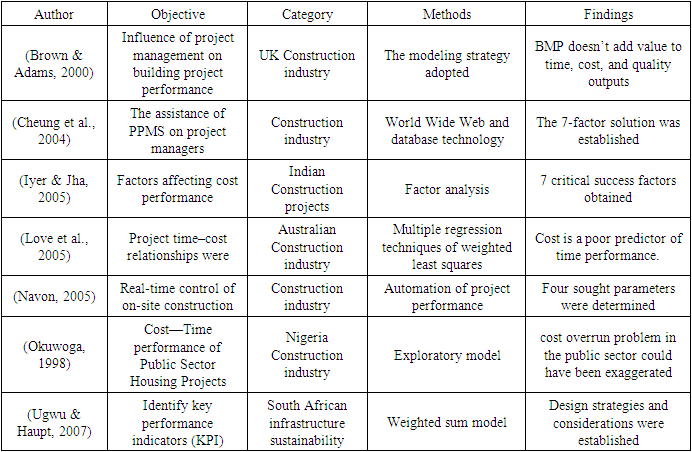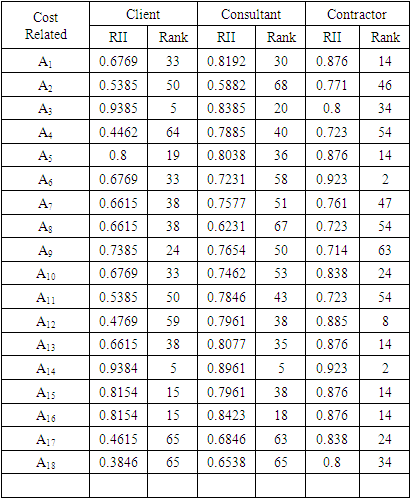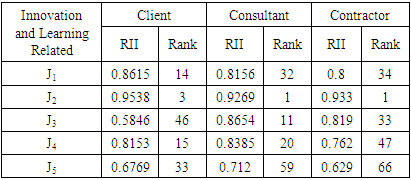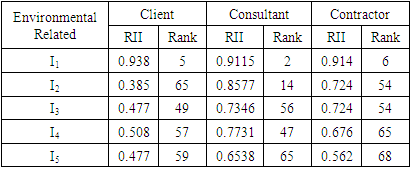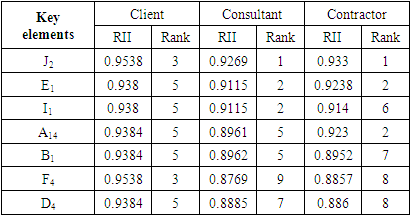| [1] | A Kassem, M., Khoiry, M. A., & Hamzah, N. (2020). Theoretical review on critical risk factors in oil and gas construction projects in Yemen. Engineering, Construction, and Architectural Management, 28(4), 934–968. https://doi.org/10.1108/ECAM-03-2019-0123. |
| [2] | Adjei, K. O., Aigbavboa, C. O., & Thwala, W. (2017). The Challenges of Cost Control Practice in the Construction Industry: A Literature Review. International Conference on Applied Sciences and Technology (ICAST), 2020(March), 14–24. https://conference.kstu.edu.gh/index.php/proceedings/article/view/97. |
| [3] | Agrawal, A., & Halder, S. (2020). Identifying factors affecting construction labor productivity in India and measures to improve productivity. Asian Journal of Civil Engineering, 21(4), 569–579. https://doi.org/10.1007/s42107-019-00212-3. |
| [4] | Ahn, S., Lee, S., & Steel, R. P. (2013). Effects of Workers’ Social Learning: Focusing on Absence Behavior. Journal of Construction Engineering and Management, 139(8), 1015–1025. https://doi.org/10.1061/(ASCE)co.1943-7862.0000680. |
| [5] | Alaloul, W. S., Liew, M. S., Zawawi, N. A. W., Mohammed, B. S., Adamu, M., & Musharat, M. A. (2020). Structural equation modeling of construction project performance based on coordination factors. Cogent Engineering, 7(1). https://doi.org/10.1080/23311916.2020.1726069. |
| [6] | Ali, M. C. (2014). Exploring the potential of integration quality assessment system in construction (classic) with ISO 9001 quality management system (QMS). International Journal for Quality Research, 8(1), 73–86. |
| [7] | Alinaitwe, H. M., Mwakali, J. A., & Hansson, B. (2007). Factors affecting the productivity of building craftsmen - studies of Uganda. Journal of Civil Engineering and Management, 13(3), 169–176. https://doi.org/10.1080/13923730.2007.9636434. |
| [8] | Amin, S., Hesami, S., & Amin Lavasani, S. (2014). Identifying and Classifying Effective Factors Affecting Overhead Costs in Constructing Projects in Iran. International Journal of Construction Engineering and Management, 3(1), 24–41. https://doi.org/10.5923/j.ijcem.20140301.03. |
| [9] | Anugwo, I. C., Shakantu, W., Saidu, I., & Adamu, A. (2018). Potentiality of the South African Construction SMME Contractors Globalising within and Beyond the SADC Construction Markets. Journal of Construction Business and Management, 2(1), 41–49. https://doi.org/10.15641/jcbm.2.1.73. |
| [10] | Atkinson, R., Crawford, L., And, & Ward, S. (2006). Fundamental uncertainties in projects and the scope of project management. International Journal of Project Management, 24(8), 687–698. https://doi.org/10.1016/j.ijproman.2006.09.011. |
| [11] | Bakhary, N. A., Adnan, H., & Ibrahim, A. (2015). A Study of Construction Claim Management Problems in Malaysia. Procedia Economics and Finance, 23(October 2014), 63–70. https://doi.org/10.1016/s2212-5671(15)00327-5. |
| [12] | Benz, S. M. (1997). The Project Manager’s CADD Survival Guide. The Project Manager’s CADD Survival Guide, May. https://doi.org/10.1061/9780784402474. |
| [13] | Berroir, F., Harbouche, L., And, & Boton, C. (2015). Top down vs. Bottom up approaches regarding the implementation of lean construction through a French case study. In 23rd Annual Conference of the International Group for Lean Construction, 73–82. |
| [14] | Bisták, A., Hulínová, Z., & Neštiak, M. (2021). Simulation Modelling of Aerial Works and Its Role in the Preparation of Construction. Slovak Journal of Civil Engineering, 29(1), 20–26. https://doi.org/10.2478/sjce-2021-0004. |
| [15] | Boniface, M., & Malongo, J. (2004). Globalisation: A Challenge To The Tanzanian Construction Industry. Globalisation and Construction, 69–79. |
| [16] | BOT. (2022). Bank of Tanzania annual report: Economic update. 18. |
| [17] | Brown, A., & Adams, J. (2000). Measuring the effect of project management on construction outputs: a new approach. International Journal of Project Management, 18, 327–335. |
| [18] | Chan, A. P. C., Scott, D., & Lam, E. W. M. (2002). Framework of Success Criteria for Design/Build Projects. Journal of Management in Engineering, 18(3), 120–128. https://doi.org/10.1061/(asce)0742-597x(2002)18:3(120). |
| [19] | Cheung, S. O., Suen, H. C. H., And, & Cheung, K. K. W. (2004). PPMS: a Web-based construction project performance monitoring system. Automation in Construction, 13, 361–376. |
| [20] | Chigara, B., Moyo, T., & Mudzengerere, F. H. (2013). An analysis of cost management strategies employed By building contractors on projects in Zimbabwe. International Journal of Sustainable Construction Engineering & Technology, 4(2), 2180–3242. https://www.researchgate.net/publication/349311913. |
| [21] | Chin, L. S., & Hamid, A. R. A. (2015). The practice of time management on construction project. Procedia Engineering, 125, 32–39. https://doi.org/10.1016/j.proeng.2015.11.006. |
| [22] | CRB. (2004). Contractors Annual Returns. Contractors Registration Board Registry. |
| [23] | Cunningham, T. (2013). Factors Affecting The Cost of Building Work - An Overview. Dublin Institute of Technology, 0–21. |
| [24] | Dainty, A., & Leiringer, R. (2019). Maintaining a relevant construction management and economics research community. Construction Management and Economics, 37(12), 693–696. https://doi.org/10.1080/01446193.2019.1687992. |
| [25] | Dissanayaka, S. M., & Kumaraswamy, M. M. (1999). Comparing contributors to time and cost performance in building projects. Building and Environment, 34, 31–42. |
| [26] | Dobysheva, T., & Gladkova, E. (2018). Improvement of methods for determining the cost of design documentation in construction. MATEC Web of Conferences, 212. https://doi.org/10.1051/matecconf/201821209005. |
| [27] | Dounavi, L. E., Dermitzakis, E., Chatzistelios, G., & Kirytopoulos, K. (2022). Project Management for Corporate Events: A Set of Tools to Manage Risk and Increase Quality Outcomes. Sustainability (Switzerland), 14(4). https://doi.org/10.3390/su14042009. |
| [28] | Enshassi, A., Mohamed, S., Mustafa, Z. A., And, & Mayer, P. E. (2007). Factors affecting labour productivity in building projects in the Gaza strip. Journal of Civil Engineering and Management, 13(4), 245–254. https://doi.org/10.1080/13923730.2007.9636444. |
| [29] | Fellows, R. F., Langford, D., Newcombe, R., & Urry, S. (2009). Construction management in practice. John Wiley & Sons. |
| [30] | Forcada, N., Gangolells, M., Casals, M., & Macarulla, M. (2017). Factors Affecting Rework Costs in Construction. Journal of Construction Engineering and Management, 143(8). https://doi.org/10.1061/(asce)co.1943-7862.0001324. |
| [31] | Gebrehiwet, T., & Luo, H. (2017). Analysis of Delay Impact on Construction Project Based on RII and Correlation Coefficient: Empirical Study. Procedia Engineering, 196 (June), 366–374. https://doi.org/10.1016/j.proeng.2017.07.212. |
| [32] | Hanna, A. S., & Sullivan, K. T. (2004). Impact of overtime on construction labor productivity. Cost Engineering (Morgantown, West Virginia), 46(4), 20–27. |
| [33] | Iyer, K. C. ., & Jha, K. N. (2005). Factors affecting cost performance: evidence from Indian construction projects. International Journal of Project Management, 23, 283–295. |
| [34] | Jaffar, N., Tharim, A. H. A., & Shuib, M. N. (2011). Factors of Conflict in Construction Industry: A Literature Review. Procedia Engineering, 20, 193–202. https://doi.org/10.1016/j.proeng.2011.11.156. |
| [35] | Jahan, S., Khan, K. I. A., Thaheem, M. J., Ullah, F., Alqurashi, M., & Alsulami, B. T. (2022). Modeling Profitability-Influencing Risk Factors for Construction Projects: A System Dynamics Approach. Buildings, 12(6). https://doi.org/10.3390/buildings12060701. |
| [36] | Jere Jacobs, & Sanders, S. (2008). Construction Management Performance;Readness Assessment for managing large projects. ScottMadden Management Consultants-North Carolina,USA. |
| [37] | Kantová, R. (2017). Construction Machines as a Source of Construction noise. Procedia Engineering, 190, 92–99. https://doi.org/10.1016/j.proeng.2017.05.312. |
| [38] | Khamaksorn, A. (2016). Project Management Knowledge and Skills for the Construction Industry. 72–77. https://doi.org/10.15242/iicbe.dir1216416. |
| [39] | Khlaifat, D. M., Alyagoub, R. E., Sweis, R. J., & Sweis, G. J. (2019). Factors leading to construction projects’ failure in Jordon. International Journal of Construction Management, 19(1), 65–78. https://doi.org/10.1080/15623599.2017.1382092. |
| [40] | Kim, S., Chang, S., & Castro-Lacouture, D. (2020). Dynamic Modeling for Analyzing Impacts of Skilled Labor Shortage on Construction Project Management. Journal of Management in Engineering, 36(1), 1–13. https://doi.org/10.1061/(asce)me.1943-5479.0000720. |
| [41] | Kothari, C. R. (2004). Research methodology: Methods and techniques. New Age International. |
| [42] | KPI. (2000). KPI Report for Minister for Construction. Department of the Environment, Transport and the Regions-The KPI Working Group, January. |
| [43] | Kuprenas, J. A. (2003). Project management actions to improve design phase cost performance, Journal of Management in Engineering. 19(1), 25–32. |
| [44] | Lee, J. S., Son, S., Kim, S., & Son, K. (2021). Correlation analysis of safety climate and construction productivity in South Korea. International Journal of Occupational Safety and Ergonomics, 27(2), 589–596. https://doi.org/10.1080/10803548.2020.1741279. |
| [45] | Levy, S. M. (2018). Project management in construction. McGraw-Hill Education. |
| [46] | Lipman, R., Palmer, M., & Palacios, S. (2011). Assessment of conformance and interoperability testing methods used for construction industry product models. Automation in Construction, 20(4), 418–428. https://doi.org/10.1016/j.autcon.2010.11.011. |
| [47] | Love, P. E. D., Tse, R. Y. C., And, & Edwards, D. J. (2005). Time-cost relationships in australian building construction projects. Journal of Construction Engineering and Management, 131(2), 187–194. |
| [48] | Lu, S., & Yan, H. (2013). A comparative study of the measurements of perceived risk among contractors in China. International Journal of Project Management, 31(2), 307–312. https://doi.org/10.1016/j.ijproman.2012.06.001. |
| [49] | Manap, N., Mohd Noh, N. H., & Syahrom, N. (2018). Recruitment criteria and attraction strategies for local trained labour in Malaysia’s construction industry. IOP Conference Series: Earth and Environmental Science, 109(1). https://doi.org/10.1088/1755-1315/109/1/012011. |
| [50] | Maylor, H., Vidgen, R., And, & Carver., S. (2008). Managerial complexity in project-based operations: A grounded model and its implications for practice. Project Management Journal, 39(1), 15-26. |
| [51] | Mengistu, D. G., & Mahesh, G. (2020). Dimensions for improvement of construction management practice in Ethiopian construction industry. Journal of Engineering, Design and Technology, 18(1), 21–39. https://doi.org/10.1108/JEDT-10-2018-0175. |
| [52] | Moza, A., Paul, V. K., & Solanki, S. K. (2022). Evaluating Project Complexity in Construction Sector in India. Journal of Engineering Research and Sciences, 1(5), 198–212. https://doi.org/10.55708/js0105021. |
| [53] | Navon, R. (2005). Automated project performance control of construction projects. Automation in Construction, 14, 467–476. |
| [54] | Nguyen, L. D., Ogunlana, S. O., & Lan, D. T. X. (2004). A study on project success factors in large construction projects in Vietnam. Engineering, Construction and Architectural Management, 11(6), 404–413. https://doi.org/10.1108/09699980410570166. |
| [55] | Niittymäki, O. I. & S. (2015). CONSTRUCTION MANAGEMENT Study Book. Häme University of Applied Sciences. |
| [56] | Nitithamyong, P., & Skibniewski, M. J. (2006). Success/Failure Factors and Performance Measures of Web-Based Construction Project Management Systems: Professionals’ Viewpoint. Journal of Construction Engineering and Management, 132(1), 80–87. https://doi.org/10.1061/(asce)0733-9364(2006)132: 1(80). |
| [57] | Noruwa, B. I., Arewa, A. O., & Merschbrock, C. (2022). Effects of emerging technologies in minimising variations in construction projects in the UK. International Journal of Construction Management, 22(11), 2199–2206. https://doi.org/10.1080/15623599.2020.1772530. |
| [58] | Okuwoga, A. A. (1998). Cost-time performance of public sector housing projects in Nigeria. Habitat Intl., 22(4), 389–395. |
| [59] | Omopariola, E. D., Windapo, A., Edwards, D. J., & Thwala, W. D. (2020). Contractors’ perceptions of the effects of cash flow on construction projects. Journal of Engineering, Design and Technology, 18(2), 308–325. https://doi.org/10.1108/JEDT-04-2019-0099. |
| [60] | Passer, A., Kreiner, H., & Maydl, P. (2012). Assessment of the environmental performance of buildings: A critical evaluation of the influence of technical building equipment on residential buildings. International Journal of Life Cycle Assessment, 17(9), 1116–1130. https://doi.org/10.1007/s11367-012-0435-6. |
| [61] | Paton-Cole, V. P., & Aibinu, A. A. (2021). Construction Defects and Disputes in Low-Rise Residential Buildings. Journal of Legal Affairs and Dispute Resolution in Engineering and Construction, 13(1). https://doi.org/10.1061/(asce)la.1943-4170.0000433. |
| [62] | Perrenoud, A. J., & Sullivan, K. T. (2017). Analysis of Executive Succession Planning in 12 Construction Companies. International Journal of Construction Education and Research, 13(1), 64–80. https://doi.org/10.1080/15578771.2016.1143892. |
| [63] | Pheng, L. S., & Chuan, Q. T. (2006). Environmental factors and work performance of project managers in the construction industry. International Journal of Project Management, 24, 24–37. |
| [64] | Portny, S. E. (2015). Project Management For Dummies. In Wiley Publishing (Vol. 14, Issue 1). |
| [65] | Robichaud, L. B., & Anantatmula, V. S. (2011). Greening Project Management Practices for Sustainable Construction. Journal of Management in Engineering, 27(1), 48–57. https://doi.org/10.1061/(asce)me.1943-5479.0000030. |
| [66] | Rowlinson, S., Yunyanjia, A., Li, B., & Chuanjingju, C. (2014). Management of climatic heat stress risk in construction: A review of practices, methodologies, and future research. Accident Analysis and Prevention, 66, 187–198. https://doi.org/10.1016/j.aap.2013.08.011. |
| [67] | Rwelamila P.D. (2000). African Construction Industries in Turmoil?. The Implications for NEPAD. Proceedings of the CIB W107 1st International Conference., Stellenboch South Africa. |
| [68] | Sage, D., Dainty, A., & Brookes, N. (2014). A critical argument in favor of theoretical pluralism: Project failure and the many and varied limitations of project management. International Journal of Project Management, 32(4), 544–555. https://doi.org/10.1016/j.ijproman.2013.08.005. |
| [69] | Sasitharan Nagapan, Ismail Abdul Rahman, & Ade Asmi. (2011). A Review of Construction Waste Cause Factors. Conference of Real Estate: Sustainable Growth Managing Challenges, Johor Bahru, Malaysia. http://eprints.uthm.edu.my/2665/. |
| [70] | Shenhar, A., Dvir, D., Levy, O., & Maltz, A. (2001). Project Success:a multidimentional strategic concept. Long Range Planning, no 34, 699–725. |
| [71] | Smith, P. (2014). Project Cost Management – Global Issues and Challenges. Procedia - Social and Behavioral Sciences, 119, 485–494. https://doi.org/10.1016/j.sbspro.2014.03.054. |
| [72] | Smith, P. (2016). Global Professional Standards for Project Cost Management. Procedia - Social and Behavioral Sciences, 226 (October 2015), 124–131. https://doi.org/10.1016/j.sbspro.2016.06.170. |
| [73] | Tam, C. M., Zeng, S. X., & Deng, Z. M. (2004). Identifying elements of poor construction safety management in China. Safety Science, 42(7), 569–586. https://doi.org/10.1016/j.ssci.2003.09.001. |
| [74] | Ugwu, O. O., & Haupt, T. C. (2007). Key performance indicators and assessment methods for infrastructure sustainability – a South African construction industry perspective. Building and Environment, 42, 665–680. |
| [75] | URT. (2003). Construction Industry Policy. National Construction Council(NCC). |
| [76] | Van Wyngaard, C. J., Pretorius, J. H. C., & Pretorius, L. (2012). Theory of the triple constraint -A conceptual review. IEEE International Conference on Industrial Engineering and Engineering Management, 1991–1997. https://doi.org/10.1109/IEEM.2012.6838095. |
| [77] | Vilventhan, A., Ram, V. G., & Sugumaran, S. (2019). Value stream mapping for identification and assessment of material waste in construction: A case study. Waste Management and Research, 37(8), 815–825. https://doi.org/10.1177/0734242X19855429. |
| [78] | Wang, J., & Yuan, H. (2011). Factors affecting contractors’ risk attitudes in construction projects: Case study from China. International Journal of Project Management, 29(2), 209–219. https://doi.org/10.1016/j.ijproman.2010.02.006. |
| [79] | Wieser, A. A., Scherz, M., Passer, A., & Kreiner, H. (2021). Challenges of a healthy built environment: Air pollution in construction industry. Sustainability (Switzerland), 13(18). https://doi.org/10.3390/su131810469. |
| [80] | Willner, T., Lipshits-Braziler, Y., & Gati, I. (2020). Construction and Initial Validation of the Work Orientation Questionnaire. Journal of Career Assessment, 28(1), 109–127. https://doi.org/10.1177/1069072719830293. |
| [81] | Windapo, D. A. (2013). Fundamentals of construction management. In Construction management & Economics (1st ed.). |
| [82] | Wong, K. D. A., Wong, K. W. F., & Nadeem, A. (2011). Building information modelling for tertiary construction education in Hong Kong. Electronic Journal of Information Technology in Construction, 16, 467–476. |
| [83] | Yan, H., Elzarka, H., Gao, C., Zhang, F., & Tang, W. (2019). Critical Success Criteria for Programs in China: Construction Companies’ Perspectives. Journal of Management in Engineering, 35(1). https://doi.org/10.1061/(asce)me.1943-5479.0000659. |
| [84] | Yu, Z., Peng, H., Zeng, X., Sofi, M., Xing, H., & Zhou, Z. (2019). Smarter construction site management using the latest information technology. Proceedings of the Institution of Civil Engineers: Civil Engineering, 172(2), 89–95. https://doi.org/10.1680/jcien.18.00030. |






 The list of companies that create the population size of the study, came from construction stakeholders (i.e. clients, consultants, and contractors) based in Dar es Salaam City, Tanzania. The target populations of Clients were the recognized local real estate agents, consultants were local architectural consulting firms registered by the recognized board (in this case Architect and Quantity Surveyor Registration Board (AQRB) while contractors were the Class-V local contractors, with offices in Dar es Salaam City because 95% of the local firms are in small to medium-sized enterprises in classes 5-7 (largely class 5). The population samples were collected from the AQRB registry (as per November 2020 AQRB report) whereby there are 257 local registered architectural organizations and 24 foreign registered architectural organizations (65 firms located in Dar es Salaam), the Contractors Registration Board (CRB) registry of 2018 shows a total number of 725 class-V local building contractors (54 class-V local building contractors located in Dar Es Salaam) while for the case of real estate organization zoom Tanzania directory of 2020 indicate a total of 224 real estate agents (32 real estate organization located in Dar Es Salaam). Therefore, the population size of all the clients, consultants, and contractors is 151 respondents.The target populations of clients, consultants, and contractors depend on the registered real estate organization, design (and consultancy services), and contractors located in Dar es Salaam City only. The sample size formula for the small and finite population is provided by (Kothari, 2004) and is given as;
The list of companies that create the population size of the study, came from construction stakeholders (i.e. clients, consultants, and contractors) based in Dar es Salaam City, Tanzania. The target populations of Clients were the recognized local real estate agents, consultants were local architectural consulting firms registered by the recognized board (in this case Architect and Quantity Surveyor Registration Board (AQRB) while contractors were the Class-V local contractors, with offices in Dar es Salaam City because 95% of the local firms are in small to medium-sized enterprises in classes 5-7 (largely class 5). The population samples were collected from the AQRB registry (as per November 2020 AQRB report) whereby there are 257 local registered architectural organizations and 24 foreign registered architectural organizations (65 firms located in Dar es Salaam), the Contractors Registration Board (CRB) registry of 2018 shows a total number of 725 class-V local building contractors (54 class-V local building contractors located in Dar Es Salaam) while for the case of real estate organization zoom Tanzania directory of 2020 indicate a total of 224 real estate agents (32 real estate organization located in Dar Es Salaam). Therefore, the population size of all the clients, consultants, and contractors is 151 respondents.The target populations of clients, consultants, and contractors depend on the registered real estate organization, design (and consultancy services), and contractors located in Dar es Salaam City only. The sample size formula for the small and finite population is provided by (Kothari, 2004) and is given as;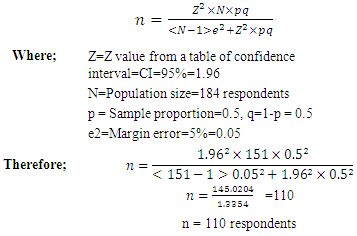
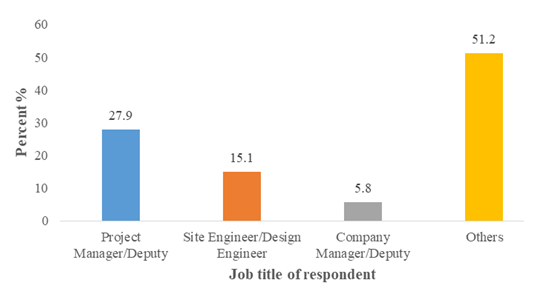
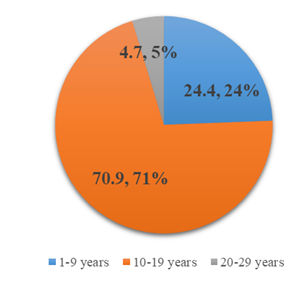

 Abstract
Abstract Reference
Reference Full-Text PDF
Full-Text PDF Full-text HTML
Full-text HTML